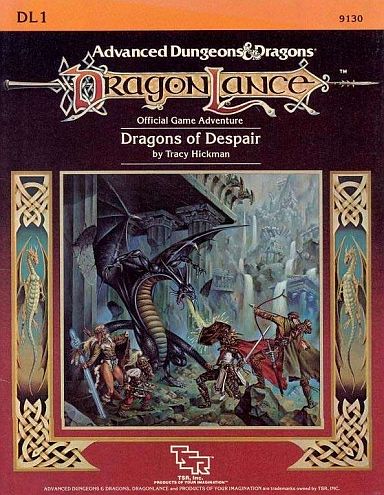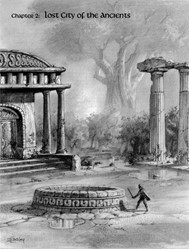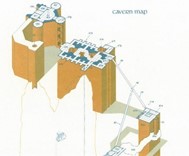 With Dragons of Despair, TSR launched the Dragonlance property, and we moved into a new era of D&D.
With Dragons of Despair, TSR launched the Dragonlance property, and we moved into a new era of D&D.
It’s really hard to understate how important Dragonlance is to the history of D&D. The story was told through both adventures and novels, and for the first time TSR were concentrating on telling a really big story through their products.
We’d seen hints of this approach to storytelling through adventures through the work of TSR UK and Tracy Hickman’s previous adventures, but this was on another scale altogether. Paizo’s Adventure Paths and Wizards’ Tyranny of Dragons have their beginnings here. Dragonlance got a lot of things wrong, as is to be expected of any ground-breaking product, but it got a lot of things right as well.
One of the things it got absolutely right was the trilogy of accompanying novels. Stylistically, they have their flaws, but the story they tell is compelling. (They worked especially well for the teenage me, back almost thirty years ago). However, the release of those books cast a long shadow over the adventure modules. If you’ve read the novels, what can the adventures offer that the novels can’t? And, perhaps more pertinently, does reading the novels spoil the experience of playing the adventures?
And then there’s the biggest of all problems about presenting a story through both adventures and novels: Are you telling the same story in both? For Dragonlance, the answer was yes (for the most part). The correspondence between the plot of the adventures and the plot of the novels would be the biggest issue in how these adventures were received. When the adventure starts to tell you how a player must act for the story to proceed, then problems can arise. The term we use for this is railroading, and there’s more than a little of this in the series.
However, it’s quite odd to discover that isn’t actually the problem with Dragons of Despair. Yes, the players have to perform certain actions, but Dragons of Despair tries other tactics rather than just telling the players where to go.
The basic plot of the adventure is that the player characters have returned to their hometown being apart for five years. They have been seeking proof of the existence of the gods; the gods having abandoned the world hundreds of years ago after an event known as the Cataclysm. Back home, they discover that numerous groups – including a strange group of reptile men – are seeking the Blue Crystal Staff. They meet up with the bearer of the staff and eventually make their way with her to Xak Tsaroth, where they learn that the gods are indeed real and they are returning to the world, with one of the characters becoming the first true cleric since the Cataclysm.
Oh, and dragons have also returned to the world, and a great army is now conquering their land!
 Yes, it’s a lot to get through. Tracy Hickman is the designer of this adventure and the entire Dragonlance series was his idea (although aided by many other TSR staff along the way). As TSR’s best adventure designer, it’s a good thing he was starting off the series, but it is a bumpy start.
Yes, it’s a lot to get through. Tracy Hickman is the designer of this adventure and the entire Dragonlance series was his idea (although aided by many other TSR staff along the way). As TSR’s best adventure designer, it’s a good thing he was starting off the series, but it is a bumpy start.
Dragons of Despair drops the characters into an unfamiliar world and then expects them to work out what to do, with a few hints that there is a lot of interest in a Blue Crystal Staff. Hickman designed a large section of the local countryside for the initial section of the adventure. There are a number of clues pointing the characters towards Xak Tsaroth, from which the Blue Crystal Staff came, but my experience running it is that the players are quite lost at the beginning. The initial encounter doesn’t really drive in the point – there’s a throw-away reference to the staff and then the party is attacked by goblins. The reaction of the characters in the book actually drives this home – they’re concerned by goblins being around their home rather than any mention of a Blue Crystal Staff!
With thirty more years’ knowledge of adventure-design techniques, we can see the problems with the initial part of Dragons of Despair. It needs the techniques of event-driven play, but those techniques are in their infancy; most adventures of the time were site-based (certainly most D&D ones!) Dragons of Despair takes steps towards this approach by having several Events that take place dependent on time, not location, but their use is still fairly clumsy and limited, the most notable use being the invasion of the Dragonarmies, which cause the countryside and towns to fall to their forces (and probably force the players towards Xak Tsaroth if they’re still unsure of where to go).
The actual clues to get the characters moving towards Xak Tsaroth can be rather blunt. An old storyteller in the Inn of the Last Home just straight-out tells the group they need to go there. The first time I ran the adventure, with players who had read the books, they listened to his advice and went straight there, completely bypassing the initial stages of the adventure. It was probably a mercy for all concerned, as I was a very inexperienced DM in those days!
These days, I can see what Tracy Hickman was aiming for – my comprehension aided a lot by reading how the initial stages proceed in the novel – but the first section of the adventure definitely has its problems.
 Once the adventure gets to Xak Tsaroth, however, things get much better. Tracy Hickman had already made a name for himself as a designer of interesting dungeons, and Xak Tsaroth is no exception: it is a ruined city, cast down the side of a cliff so that the buildings are now on many levels, and the players must crawl over treacherous pathways (or use a primitive elevator controlled by the enemy) to negotiate it. The city’s map, drawn in isomorphic fashion by David “Diesel” LaForce, is a masterpiece.
Once the adventure gets to Xak Tsaroth, however, things get much better. Tracy Hickman had already made a name for himself as a designer of interesting dungeons, and Xak Tsaroth is no exception: it is a ruined city, cast down the side of a cliff so that the buildings are now on many levels, and the players must crawl over treacherous pathways (or use a primitive elevator controlled by the enemy) to negotiate it. The city’s map, drawn in isomorphic fashion by David “Diesel” LaForce, is a masterpiece.
Part of what makes Dragons of Despair and the entire Dragonlance series so memorable is the sheer amount of invention here. There was a very clear desire to distance the adventure from the influences of Tolkien. Orcs are absent from Krynn and the halflings have been entirely recast as kender, inquisitive kleptomaniacs with no fear – about as far as the hobbits of the Shire as you can imagine! The chief soldiers of the Dragonarmies, Draconians – reptile men of mysterious origins – are introduced in a manner to increase the mystery of their origins. Tracy Hickman’s ability to write inspiring prose and descriptions is also in full view here, as the adventure is filled with evocative descriptions of the things the players find.
Although I’ve criticised how the adventure doesn’t really give the players enough of an idea of their home lands, it does at least attempt to ground them in the mythic underpinnings of the world: the story of the first great fight against the dragons, which led to their banishing from the realm, and the Cataclysm that occurred when the gods turned their faces from the world. This is done through a magnificent eight-stanza poem, the Canticle of the Dragon, most likely written by Michael Williams (who was working as an editor at TSR at the time, and, indeed, edited this adventure). The module also includes – of all things – a song! Unfortunately, the printing of the song in the book ran into a few technical hitches, so that the notes aren’t properly placed on the staves. (My teenage self was still able to work out where they should have been, and rather enjoyed playing it and the other music that would come in later modules).
The artwork, by Jeff Easley and Clyde Caldwell, is superb. One thing Dragonlance did was really display what a talented team of artists could do. If I have one complaint with the production values of the adventure, it is in the DM’s wilderness map, which is a blurry black & white reproduction of the players’ map; it is very hard to distinguish features on it. However, Hickman made one great innovation with the map: he divided it up to regions where the encounters would occur whenever the region was entered rather than just a specific hex; this greatly enhanced the play of the adventure.
This then is Dragons of Despair, the first of the Dragonlance adventures. It’s an ambitious adventure, and one that has a lot of great design in it, along with some parts that don’t quite work as intended. Despite its flaws, it’s one of my favourite adventures ever written for D&D. The real problems with the Dragonlance adventures would appear in later adventures, with the next adventure, Dragons of Flame showing exactly what the perils were with the novels and adventure story going hand-in-hand…
(Dragons of Despair is available in pdf-format from dndclassics.com. It’s a pretty good scan, although the map of Xak Tsaroth has been split into two pieces that are separated: at the beginning and end of the book.)

I found the early parts of this adventure extremely confusing. Is Riverwind supposed to be an NPC or a PC? Apparently he is encountered together with Goldmoon who is clearly a PC. Does the party recruit them because of the healing powers? The GM and players get very little guidance on the roleplaying! I didn’t even know the characters were heading TOWARDS Solace town at the beginning or why. Are the dragonians supposed to shock and bewilders the players? Do they know what they are?
This one really needed a lot of background lore exposition at the start to get authentic reactions from the players.
Did you like the “Sandbox” format for an adventure that should clearly be an event driven/railroad thing? It felt disingenuous. But I suppose it makes sense given that those sort of adventures hadn’t been developed yet.
One of my favorite modules of all time. I played it as a character when it first came out and the have since mastered it numerous times. Play the opening sequences as if the players have never played d and d before. It allows for the maine part of the story to be delayed a bit and doesn’t make you feel like this big bulk of material has been wasted ot bypassed because the party simply find Xak Saroth directly.
Here’s what has confused me as I have considered running these adventures. What do you do if one of the key PCs dies? It appears that these PCs, and these specific PCs play important roles as the modules progress. I’m wondering how one is expected to handle Raistlin getting hit by the Khisanth’s acid breath with his 8 hit points. Who is to enter the tower of high sorcery if Raistlin is dead 9 modules earlier?